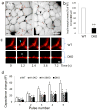Deletion of Ia-2 and/or Ia-2β in mice decreases insulin secretion by reducing the number of dense core vesicles
- PMID: 21732083
- PMCID: PMC3168514
- DOI: 10.1007/s00125-011-2221-6
Deletion of Ia-2 and/or Ia-2β in mice decreases insulin secretion by reducing the number of dense core vesicles
Abstract
Aims/hypothesis: Islet antigen 2 (IA-2) and IA-2β are dense core vesicle (DCV) transmembrane proteins and major autoantigens in type 1 diabetes. The present experiments were initiated to test the hypothesis that the knockout of the genes encoding these proteins impairs the secretion of insulin by reducing the number of DCV.
Methods: Insulin secretion, content and DCV number were evaluated in islets from single knockout (Ia-2 [also known as Ptprn] KO, Ia-2β [also known as Ptprn2] KO) and double knockout (DKO) mice by a variety of techniques including electron and two-photon microscopy, membrane capacitance, Ca(2+) currents, DCV half-life, lysosome number and size and autophagy.
Results: Islets from single and DKO mice all showed a significant decrease in insulin content, insulin secretion and the number and half-life of DCV (p < 0.05 to 0.001). Exocytosis as evaluated by two-photon microscopy, membrane capacitance and Ca(2+) currents supports these findings. Electron microscopy of islets from KO mice revealed a marked increase (p < 0.05 to 0.001) in the number and size of lysosomes and enzymatic studies showed an increase in cathepsin D activity (p < 0.01). LC3 protein, an indicator of autophagy, also was increased in islets of KO compared with wild-type mice (p < 0.05 to 0.01) suggesting that autophagy might be involved in the deletion of DCV.
Conclusions/interpretation: We conclude that the decrease in insulin content and secretion, resulting from the deletion of Ia-2 and/or Ia-2β, is due to a decrease in the number of DCV.
Conflict of interest statement
No potential conflicts of interest relevant to this article were reported.
Figures







Similar articles
-
Insulin secretion in islets from mice with a double knockout for the dense core vesicle proteins islet antigen-2 (IA-2) and IA-2beta.J Endocrinol. 2008 Mar;196(3):573-81. doi: 10.1677/JOE-07-0496. J Endocrinol. 2008. PMID: 18310453
-
Disturbances in the secretion of neurotransmitters in IA-2/IA-2beta null mice: changes in behavior, learning and lifespan.Neuroscience. 2009 Mar 17;159(2):427-37. doi: 10.1016/j.neuroscience.2009.01.022. Neuroscience. 2009. PMID: 19361477 Free PMC article.
-
Disruption of the transmembrane dense core vesicle proteins IA-2 and IA-2beta causes female infertility.Endocrinology. 2006 Feb;147(2):811-5. doi: 10.1210/en.2005-0638. Epub 2005 Nov 3. Endocrinology. 2006. PMID: 16269463
-
[Visualizing exocytosis of insulin granules with evanescent wave microscopy].Seikagaku. 2003 Jan;75(1):49-54. Seikagaku. 2003. PMID: 12645134 Review. Japanese. No abstract available.
-
IA-2 and IA-2beta: the immune response in IDDM.Diabetes Metab Rev. 1998 Mar;14(1):85-93. doi: 10.1002/(sici)1099-0895(199803)14:1<85::aid-dmr205>3.0.co;2-i. Diabetes Metab Rev. 1998. PMID: 9605631 Review.
Cited by
-
In focus in HCB.Histochem Cell Biol. 2024 Mar;161(3):207-209. doi: 10.1007/s00418-024-02271-3. Histochem Cell Biol. 2024. PMID: 38416164 No abstract available.
-
Genome-wide associations between genetic and epigenetic variation influence mRNA expression and insulin secretion in human pancreatic islets.PLoS Genet. 2014 Nov 6;10(11):e1004735. doi: 10.1371/journal.pgen.1004735. eCollection 2014 Nov. PLoS Genet. 2014. PMID: 25375650 Free PMC article.
-
Immunological markers in type 1 diabetes mellitus in Thi-Qar province, southern Iraq.J Med Life. 2022 Oct;15(10):1234-1239. doi: 10.25122/jml-2021-0387. J Med Life. 2022. PMID: 36420297 Free PMC article.
-
Integrated DNA methylation analysis reveals a potential role for PTPRN2 in Marfan syndrome scoliosis.JOR Spine. 2024 Jan 29;7(1):e1304. doi: 10.1002/jsp2.1304. eCollection 2024 Mar. JOR Spine. 2024. PMID: 38304329 Free PMC article.
-
Genome-wide DNA methylation analysis of human pancreatic islets from type 2 diabetic and non-diabetic donors identifies candidate genes that influence insulin secretion.PLoS Genet. 2014 Mar 6;10(3):e1004160. doi: 10.1371/journal.pgen.1004160. eCollection 2014 Mar. PLoS Genet. 2014. PMID: 24603685 Free PMC article.
References
-
- Lan MS, Lu J, Goto Y, Notkins AL. Molecular cloning and identification of a receptor-type protein tyrosine phosphatase, IA-2, from human insulinoma. DNA Cell Biol. 1994;13:505–514. - PubMed
-
- Verge CF, Gianani R, Kawasaki E, et al. Prediction of type I diabetes in first-degree relatives using a combination of insulin, GAD, and ICA512bdc/IA-2 autoantibodies. Diabetes. 1996;45:926–933. - PubMed
-
- Bingley PJ, Bonifacio E, Gale EA. Can we really predict IDDM? Diabetes. 1993;42:213–220. - PubMed
Publication types
MeSH terms
Substances
Grants and funding
LinkOut - more resources
Full Text Sources
Medical
Molecular Biology Databases
Research Materials
Miscellaneous

